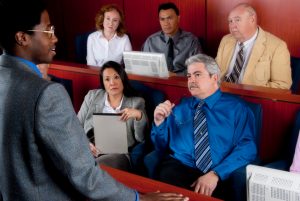Browsing the Complexities of Test Presentations: Tips for Seamless Delivery and Engaging Arguments
In the realm of legal procedures, the art of trial presentation stands as an important component of success. The intricacies integral in test discussions call for a fragile equilibrium of finesse, technique, and skill.

Recognizing Test Purposes
To effectively navigate a trial, it is important to have a clear understanding of the purposes that require to be attained. Prior to tipping right into the courtroom, legal teams should specify their objectives and wanted outcomes. These objectives work as guiding principles throughout the trial, shaping strategies and influencing decision-making processes.
Understanding test purposes entails a thorough evaluation of the instance, lawful criteria, and the customer's benefits. Trial Presentations. It needs a precise evaluation of the facts, identifying key concerns, and preparing for possible difficulties. By setting quantifiable and details objectives, attorneys can tailor their debates and discussions to align with the wanted outcomes
Furthermore, a clear grasp of test goals allows legal groups to prioritize proof, witnesses, and lawful arguments effectively. It permits for the advancement of a coherent story that resonates with the judge and court, enhancing the overall situation presentation.

Organizing Evidence Properly
Having a clear understanding of test goals lays the foundation for arranging proof efficiently in lawful process - Trial Presentations. By lining up the presentation of proof with the preferred outcomes of the test, legal groups can enhance their arguments and boost their persuasiveness. One vital element of arranging proof is categorization. Organizing evidence based upon styles or relevance to certain legal components can assist simplify the discussion and make complex details much more absorbable for the judge or court.
Another secret component in organizing proof effectively is establishing a sensible flow. Providing proof in a coherent and consecutive way can aid build an engaging story that supports the legal debates being made. Additionally, utilizing aesthetic help such as charts, charts, or timelines can additionally enhance the organization of proof and aid in clarifying complex connections or series of occasions.
Furthermore, guaranteeing that all proof offered is appropriate and acceptable to the case is important. Irrelevant or inadmissible evidence can take away from the stamina of the debate and possibly damage the reliability of the providing celebration. A meticulous review and selection see procedure need to be taken on to consist of just the most lawfully sound and impactful proof in the test discussion.
Crafting Convincing Narratives
Crafting engaging narratives plays a crucial function in offering convincing arguments throughout lawful procedures. When creating a narrative for a test presentation, it is crucial to establish a clear story that highlights key factors and attaches them in a meaningful fashion. By weaving together proof, testimony, and legal debates into a convincing and natural narrative, legal specialists can effectively advocate for their customers and browse around these guys raise the possibility of a desirable outcome in the court.
Understanding Visual Aids
Efficient usage of aesthetic aids is essential to improving the influence and clarity of trial discussions. Aesthetic help, when utilized tactically, have the power to streamline intricate details, reinforce bottom lines, and leave an enduring impact on the court and court. To master visual aids in trial presentations, it is vital to make certain that they are clear, succinct, and relevant to the arguments being made.
When incorporating visual aids, such as charts, timelines, photos, or graphs, into a trial presentation, it is necessary to keep them aesthetically appealing yet professional. The visuals need to enhance the spoken debates, giving a graph of the info being gone over without overwhelming the audience with unnecessary information.
In addition, experimenting the aesthetic aids beforehand is vital to make sure a seamless delivery throughout the test. Familiarizing oneself with the content, transitions, and timings of each use this link aesthetic help can assist maintain the circulation of the presentation and prevent technical problems that might develop.
Delivering Impactful Closing Debates
A compelling closing disagreement offers as the conclusion of a test presentation, encapsulating the core story and persuading the court and court towards a positive decision. Begin by describing the major arguments that sustain your customer's position, highlighting why the proof offered throughout the trial supports your story.
Furthermore, integrating emotional charm can additionally enhance your closing disagreement. Eventually, a well-crafted closing disagreement must leave an enduring impact, engaging the court and jury to rule in your client's favor.
Conclusion
Finally, mastering test discussions entails recognizing goals, organizing evidence, crafting narratives, utilizing aesthetic help, and providing impactful closing disagreements. By executing these techniques effectively, lawyers can offer their instance effortlessly and make compelling arguments in the courtroom. It is critical to browse the complexities of trial discussions with accuracy and skill to attain success in lawful procedures.
By aligning the discussion of evidence with the desired end results of the test, legal groups can enhance their arguments and boost their persuasiveness (Trial Presentations). To grasp visual help in trial discussions, it is vital to make sure that they are clear, concise, and pertinent to the disagreements being made
An engaging closing disagreement serves as the end result of a trial discussion, encapsulating the core story and convincing the court and jury in the direction of a positive decision. Begin by laying out the main debates that support your customer's position, stressing why the evidence offered throughout the trial sustains your narrative.In final thought, mastering trial discussions includes recognizing objectives, arranging evidence, crafting narratives, making use of visual help, and delivering impactful closing disagreements.